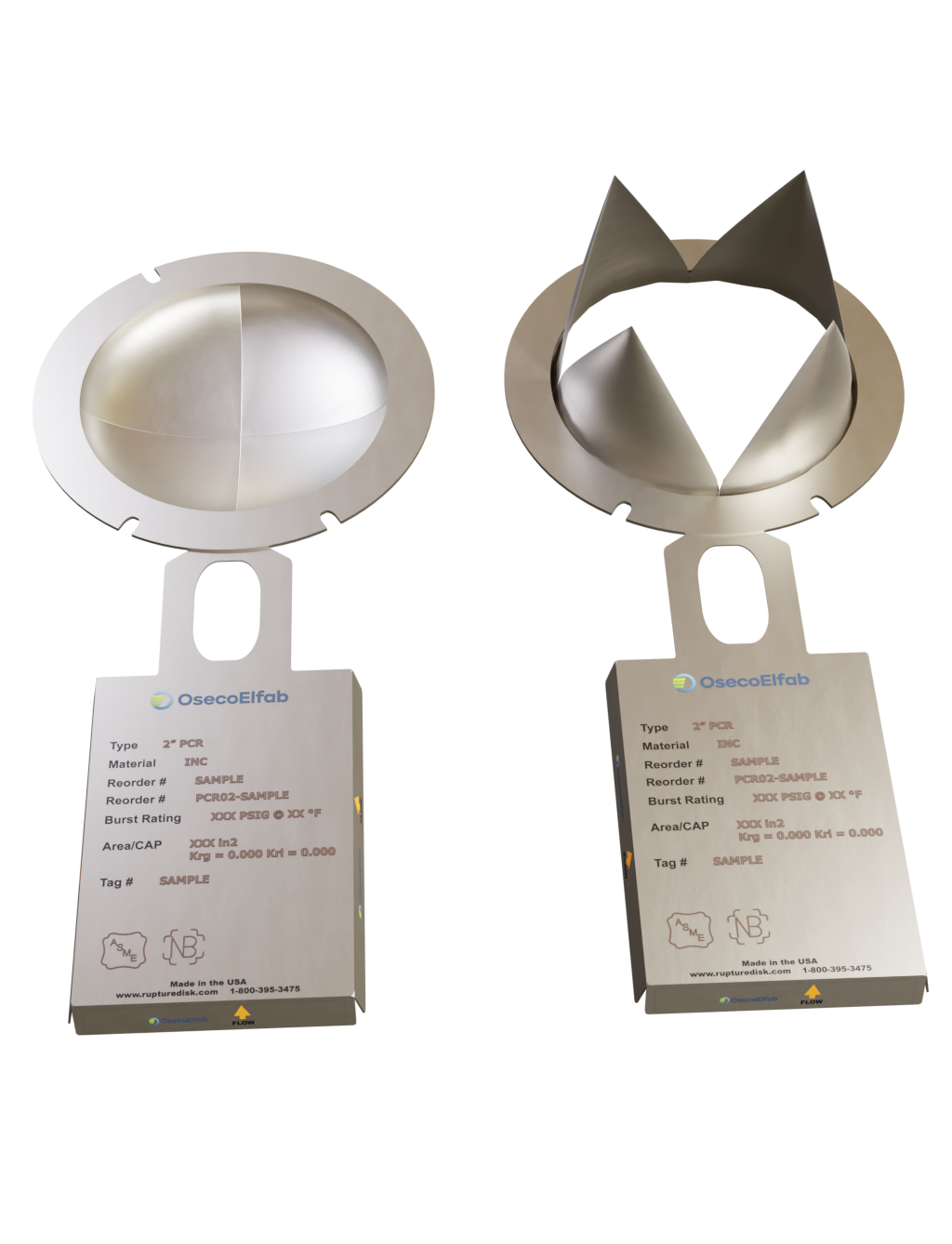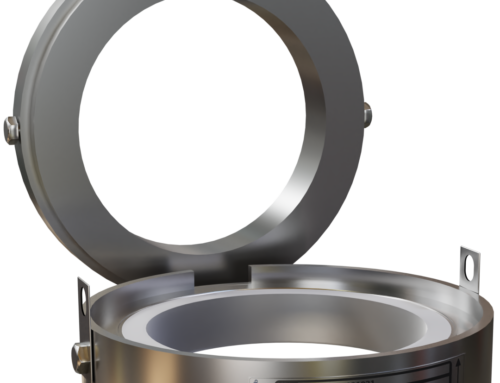OsecoElfab’s PSR Rupture Disc
OsecoElfab manufactures the PSR rupture disk, which is a high-performance, reverse acting rupture disc designed and manufactured for extremely demanding rupture disc applications. OsecoElfab’s PSR is a cross-scored, reverse buckling rupture disc. The PSR is scored on the vent side to reduce buildup of process media and contamination. It opens along these scored lines and is designed to be non-fragmenting. This process yields a high-performance disc able to withstand high operating pressures within the most difficult applications. The PSR is excellent for relief valve isolation and excels in extreme cycling or high vacuum/back pressure applications.
- The PSR is available in line sizes ranging from 1 inch diameter up to 8 inches diameter.
- The PSR is available in burst pressures ranging from 15 psig up to 125 psig.
- The PSR is available in burst temperatures ranging from cryogenic temperatures all the way up to 1000 degrees F.
- The PSR is available in all OE standard materials (316 Stainless Steel, Nickel 200, Inconel 600, Monel 400, and Hastelloy C 276). Other materials may be available or offered on request.
- The PSR works well in gas or vapor services, as well as liquid and slurry services.
- The Kr value for the PSR is Krgl = 2.13.
- The PSR has a 90% operating ratio, meaning the PSR operates reliably and with a long service life at pressures up to 90% of the marked burst pressure. Pressure excursions above this 90% operating ratio will shorten the lifespan of the PSR.
- The PSR is only offered with a 0% Manufacturing Design Range (MDR), meaning there will never be any variation between what burst pressure you order, and what burst pressure is marked on the tag of the rupture disk.
- The PSR maintains or exceeds the ASME-specified burst tolerances of +/- 5% of marked burst pressure for burst pressures above 40 psig, or +/- 2 psig for burst pressures at or below 40 psig.
- The PSR is a scored metal rupture disk, with a non-fragmenting design, meaning the PSR can be installed upstream from a pressure relief valve.
- The PSR does not use a vacuum support. The PSR is designed to handle vacuum services without any additional design enhancements.
- The PSR is a reverse acting metal rupture disk. Process pressure is applied to the convex side of the rupture disk. Increasing process pressure collapses the dome of the rupture disk until the dome inverts, and the metal yields and tears open along the scored lines.
- The PSR, like all reverse acting metal rupture disks, does best in static pressure applications, but also handles pressure cyclic services extraordinarily well. The PSR has been tested in excess of 1,000,000 full scale pressure cycles (0 psig to 90% of marked burst pressure and back down to 0 psig again), with no evidence of fatigue induced failure or alteration of burst pressure.
- The PSR is offered with a PFA liner or shield on the inlet side of the rupture disk, to enhance corrosion protection. This configuration is called the PSR-L
- The PSR is designed, manufactured, and certified to ASME BPVC Section XIII requirements.
- The PSR is designed to pair with the PRDI insert holder, as well as the PRDI-P pretorqued insert holder, as well as the Safety Cartridge one-piece holder assembly.
- The MNFA for a 1.0″ PSR is 0.6 square inches
- The MNFA for a 1.5″ PSR is 1.3 square inches
- The MNFA for a 2.0″ PSR is 2.5 square inches
- The MNFA for a 3.0″ PSR is 4.8 square inches
- The MNFA for a 4.0″ PSR is 8.0 square inches
- The MNFA for a 6.0″ PSR is 18.0 square inches
- The MNFA for a 8.0″ PSR is 32.0 square inches
- For a 1” PSR, the combined burst pressure range for all the standard OE materials (316 Stainless Steel, Nickel 200, Inconel 600, Monel 400, and Hastelloy C 276) runs from 40 psig up to a maximum burst pressure of 125 psig. Each of the standard OE materials (316 Stainless Steel, Nickel 200, Inconel 600, Monel 400, and Hastelloy C 276) has its own, more limited range within those bounds.
- For a 1″ PSR made from 316 Stainless Steel, the minimum burst pressure possible is 58 psig, and the maximum burst pressure is 125 psig.
- For a 1″ PSR made from Nickel 200, the minimum burst pressure possible is 40 psig, and the maximum burst pressure is 125 psig.
- For a 1″ PSR made from Inconel 600, the minimum burst pressure possible is 66 psig, and the maximum burst pressure is 125 psig.
- For a 1″ PSR made from Monel 400, the factory must be contacted to discuss available burst pressures.
- For a 1″ PSR made from Hastelloy C 276, the factory must be contacted to discuss available burst pressures.
- For a 1.5” PSR, the combined burst pressure range for all the standard OE materials (316 Stainless Steel, Nickel 200, Inconel 600, Monel 400, and Hastelloy C 276) runs from 25 psig up to a maximum burst pressure of 100 psig. Each of the standard OE materials (316 Stainless Steel, Nickel 200, Inconel 600, Monel 400, and Hastelloy C 276) has its own, more limited range within those bounds.
- For a 1.5″ PSR made from 316 Stainless Steel, the minimum burst pressure possible is 47 psig, and the maximum burst pressure is 100 psig.
- For a 1.5″ PSR made from Nickel 200, the minimum burst pressure possible is 25 psig, and the maximum burst pressure is 100 psig.
- For a 1.5″ PSR made from Inconel 600, the minimum burst pressure possible is 28 psig, and the maximum burst pressure is 100 psig.
- For a 1.5″ PSR made from Monel 400, the factory must be contacted to discuss available burst pressures.
- For a 1.5″ PSR made from Hastelloy C 276, the factory must be contacted to discuss available burst pressures.
- For a 2” PSR, the combined burst pressure range for all the standard OE materials (316 Stainless Steel, Nickel 200, Inconel 600, Monel 400, and Hastelloy C 276) runs from 19 psig up to a maximum burst pressure of 100 psig. Each of the standard OE materials (316 Stainless Steel, Nickel 200, Inconel 600, Monel 400, and Hastelloy C 276) has its own, more limited range within those bounds.
- For a 2″ PSR made from 316 Stainless Steel, the minimum burst pressure possible is 44 psig, and the maximum burst pressure is 100 psig.
- For a 2″ PSR made from Nickel 200, the minimum burst pressure possible is 19 psig, and the maximum burst pressure is 100 psig.
- For a 2″ PSR made from Inconel 600, the minimum burst pressure possible is 23 psig, and the maximum burst pressure is 100 psig.
- For a 2″ PSR made from Monel 400, the factory must be contacted to discuss available burst pressures.
- For a 2″ PSR made from Hastelloy C 276, the factory must be contacted to discuss available burst pressures.
- For a 3” PSR, the combined burst pressure range for all the standard OE materials (316 Stainless Steel, Nickel 200, Inconel 600, Monel 400, and Hastelloy C 276) runs from 15 psig up to a maximum burst pressure of 75 psig. Each of the standard OE materials (316 Stainless Steel, Nickel 200, Inconel 600, Monel 400, and Hastelloy C 276) has its own, more limited range within those bounds.
- For a 3″ PSR made from 316 Stainless Steel, the minimum burst pressure possible is 31 psig, and the maximum burst pressure is 75 psig.
- For a 3″ PSR made from Nickel 200, the minimum burst pressure possible is 15 psig, and the maximum burst pressure is 75 psig.
- For a 3″ PSR made from Inconel 600, the minimum burst pressure possible is 20 psig, and the maximum burst pressure is 75 psig.
- For a 3″ PSR made from Monel 400, the factory must be contacted to discuss available burst pressures.
- For a 3″ PSR made from Hastelloy C 276, the factory must be contacted to discuss available burst pressures.
- For a 4” PSR, the combined burst pressure range for all the standard OE materials (316 Stainless Steel, Nickel 200, Inconel 600, Monel 400, and Hastelloy C 276) runs from 15 psig up to a maximum burst pressure of 75 psig. Each of the standard OE materials (316 Stainless Steel, Nickel 200, Inconel 600, Monel 400, and Hastelloy C 276) has its own, more limited range within those bounds.
- For a 4″ PSR made from 316 Stainless Steel, the minimum burst pressure possible is 29 psig, and the maximum burst pressure is 75 psig.
- For a 4″ PSR made from Nickel 200, the minimum burst pressure possible is 15 psig, and the maximum burst pressure is 75 psig.
- For a 4″ PSR made from Inconel 600, the minimum burst pressure possible is 20 psig, and the maximum burst pressure is 75 psig.
- For a 4″ PSR made from Monel 400, the factory must be contacted to discuss available burst pressures.
- For a 4″ PSR made from Hastelloy C 276, the factory must be contacted to discuss available burst pressures.
- For a 6” PSR, the combined burst pressure range for all the standard OE materials (316 Stainless Steel, Nickel 200, Inconel 600, Monel 400, and Hastelloy C 276) runs from 15 psig up to a maximum burst pressure of 50 psig. Each of the standard OE materials (316 Stainless Steel, Nickel 200, Inconel 600, Monel 400, and Hastelloy C 276) has its own, more limited range within those bounds.
- For a 6″ PSR made from 316 Stainless Steel, the minimum burst pressure possible is 29 psig, and the maximum burst pressure is 50 psig.
- For a 6″ PSR made from Nickel 200, the minimum burst pressure possible is 15 psig, and the maximum burst pressure is 50 psig.
- For a 6″ PSR made from Inconel 600, the minimum burst pressure possible is 20 psig, and the maximum burst pressure is 50 psig.
- For a 6″ PSR made from Monel 400, the factory must be contacted to discuss available burst pressures.
- For a 6″ PSR made from Hastelloy C 276, the factory must be contacted to discuss available burst pressures.
- For an 8” PSR, the combined burst pressure range for all the standard OE materials (316 Stainless Steel, Nickel 200, Inconel 600, Monel 400, and Hastelloy C 276) runs from 15 psig up to a maximum burst pressure of 50 psig. Each of the standard OE materials (316 Stainless Steel, Nickel 200, Inconel 600, Monel 400, and Hastelloy C 276) has its own, more limited range within those bounds.
- For an 8″ PSR made from 316 Stainless Steel, the minimum burst pressure possible is 29 psig, and the maximum burst pressure is 50 psig.
- For an 8″ PSR made from Nickel 200, the minimum burst pressure possible is 15 psig, and the maximum burst pressure is 50 psig.
- For an 8″ PSR made from Inconel 600, the minimum burst pressure possible is 20 psig, and the maximum burst pressure is 50 psig.
- For an 8″ PSR made from Monel 400, the factory must be contacted to discuss available burst pressures.
- For an 8″ PSR made from Hastelloy C 276, the factory must be contacted to discuss available burst pressures.





